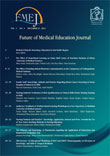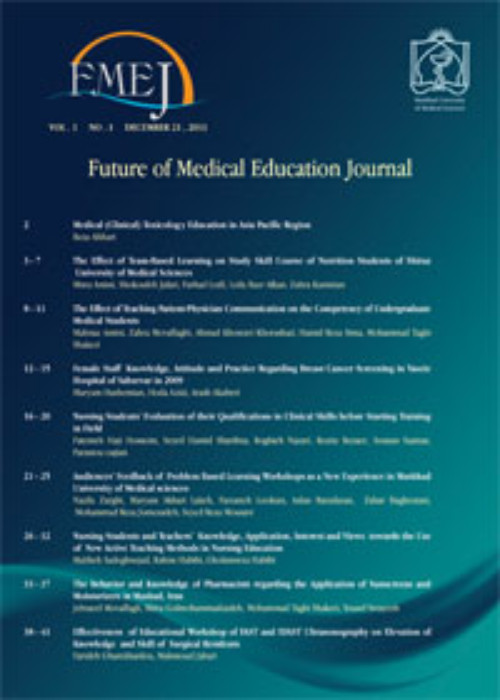فهرست مطالب

Future of Medical Education Journal
Volume:6 Issue: 3, Sep 2016
- تاریخ انتشار: 1395/09/30
- تعداد عناوین: 8
-
-
Pages 5-8BackgroundConsidering the assumptions of cognitive load theory and using its reduction and optimization strategies in the design and development of instructional content is one of the main requirements for achieving effective learning. This study examined the effectiveness of instructional multimedia based on reducing the extraneous cognitive load in English language learning among Nursing students.MethodsIn this study, pretest-posttest design with control group was used. The population included all the undergraduate students of Nursing at Alborz University of Medical Sciences in the academic year 2015-2016. Of these, 36 students were selected through a convenience sampling procedure and were randomly assigned to either of two groups in the study: control (n=17) and experimental (n=19). The instruments included instructional multimedia lessons and English grammar tests (pretest and posttest). For data analyses, an analysis of covariance (ANCOVA) was applied.ResultsThe results showed that the experimental group outperformed the control group on the posttest. This indicated that the instructional multimedia designed based on the reduction of extraneous cognitive load enhanced the learning rate of experimental group when compared to that of the control group.ConclusionsUsing instructional multimedia based on the reduction of extraneous cognitive load helps improve learning by lowering the extraneous cognitive load learners experience during the process of learning.Keywords: Instructional Multimedia, Extraneous Cognitive Load, English Learning
-
Pages 9-20BackgroundDespite progression of knowledge of nursing researcher about importance of psychometric principles of instruments of studies but it seems that this subject is not used correctly in nursing studies. This study is designed to critically assess the validity and reliability of instruments applied in studies published in Iranian nursing journalsMethodsThis study is a critical review of literature that is used the Morse Critical appraisal method. Therefore all of studies of five Iranian nursing journals that are published in1391 was selected and assessed with a researcher made checklist.ResultsIn 197 assessed articles 280 instruments consist of 245(87.5%) questionnaire and 35(12.5%) checklist was used. In 60% of instruments the validity and reliability of original copy of instrument, in 42.9% the method for confirmation of validity and in 31.8% the method for confirmation of reliability not mentioned.ConclusionsThe results of this study suggest that the quality of confirming validity and reliability of instruments applied in nursing studies is poor therefore this result can be a stimulator factor for nursing researcher to equip themselves with knowledge of psychometric to enhance and facilitate the evidence based practice.Keywords: Nursing Studies, Instrument's Validity, Reliability, Critical Appraisal, Morse Evaluation Method
-
Pages 21-24Because of approaches to learning in every place and at any time, ubiquitous learning with knowledge of the context and framework, and due to the development of wireless technologies and sensors, the learning process has changed. Mobile learning and ubiquitous learning as models of e-learning that refer to the acquisition of knowledge, attitudes and skills through wireless technologies. The effectiveness of e-learning and its new methods including mobile learning and ubiquitous learning are in need of attention to the approaches and theories of e-learning, because by employing e-learning methods, we can find solutions for teaching and learning that would meet the needs of today's education and training. In recent years, e-learning researchers have found that the development of wireless communications and sensor technology has changed the research issues of e-learning to mobile learning and then, it has changed mobile learning to ubiquitous learning.Keywords: E-learning, M-learning, U-learning
-
Pages 27-32BackgroundRelationships are the foundation of human social life. If this relationship is well established in academic environments, educational objectives are more conveniently obtained. The aim of this studyDetermining factors affecting student- professor relationship in performing educational and learning activities from the perspective of male and female apprentices, interns and Assistants students.MethodsIn this study, 240 male and female students studying at the levels of apprenticeship, internship and residency in General Surgery Department of Mashhad University of Medical Sciences were studied in the years 2013-15 for a period of 8 months over two-month terms. The standard questionnaire in three domains of personal, professional and academic characteristics was used.ResultsThe results showed that in the view of male and female students, factors of gender, student participation, academic rank of the professor and precedent of research projects and educational activities were significantly different. Moreover, a comparison of the views of apprenticeship, internship and residency students with regard to the above three domains suggested that only factors of gender, ease of access outside the class, student participation in class discussions, academic rank and the precedent of research projects and educational activities were significantly different.ConclusionsThe findings indicated that with regard to the relationship between professor and students in all above three domains, factors such as humility and modesty, popularity and reputation, agreeability, fairness, accountability, respect for students, problem solving, motivating, utilizing incentive tools, ability to communicate course materials to students, student participation in class discussions, mastery of course materials and familiarity with most recent scientific research had the highest effect whereas gender, academic rank and research precedent of the professor had the lowest effect on student-professor relationship.Keywords: Relationship, Educational Activities, Learning
-
Pages 33-38BackgroundProblem-based clinical education is an effective strategy for enhancing creativity, group work, leadership and problem-solving skills in nursing students. It seems PBL can improve nursing students critical thinking skills. The aim of this study was to investigate the effects of problem-based clinical education on nursing students critical thinking.MethodsThis randomized controlled trial was conducted in Kashan University of Medical Science in 2015. In total, 36 nursing students were recruited and were allocated to either the conventional or the problem-based clinical education. A demographic questionnaire and the California Critical Thinking Skills Test, Form B, were used for data collection. Students critical thinking skills were assessed both at the beginning of their clinical course and one week after it. The SPSS software was employed for performing the independent- and the paired-samples t as well as the Mann-Whitney U tests.ResultsThe mean of students critical thinking score in the conventional clinical education group increased significantly from 10.94±1.85 to 11.88±1.86 (P=0.016). In the problem-based education group, the mean of critical thinking score also increased from 10.72±1.44 to 13.33±1.67 (P=0.0004). Before the study, the groups did not differ significantly regarding the scores of critical thinking. However, the posttest value of critical thinking score in the problem-based education group was significantly higher than the score in the conventional education group.ConclusionsBoth conventional and problem-based clinical educations significantly improved nursing students critical thinking. However, the problem-based clinical education strategy was more effective than the conventional one.Keywords: Problem-based learning, Clinical education, Critical thinking
-
Pages 39-44BackgroundThe aims of the research that formed the basis of the current study are as follows: Determining methods that are used by teachers for giving feedback in clinical settings.
Determining types of feedback, teachers give to their students in clinical settings.
Determining barriers of giving feedback and its important teachers experience in clinical settings.MethodsThis applied research was a cross-sectional study that involved 131 medical clinical teachers.
Using resources in the library and on the web, we developed a questionnaire comprising two parts: the first part of the questionnaire focused on assessing the methods and types of giving feedback used by the participants (a total of 25 items); the second part focused on determining barriers that teachers experience when giving feedback in clinical setting (8 items).
Responses to each question were on a Likert Scale. The validity of the questionnaire was determined using content validity index (CVI) measures, and was confirmed by 10 experts. Reliability was evaluated with Cronbachs alpha coefficient.ResultsMost of the teachers (57.49%) in this study reported giving oral feedback to students, 39.1% reported giving nonverbal feedback and a few of them (3.41%) gave written feedback. Participants allowed to nominate more than one type of feedback.
Teachers reported many barriers to giving feedback to students, including lack of knowledge and skill about giving feedback, large numbers of students, lack of time, and fear of students negative reaction to feedback. Also, concern about negatively impacting the relationship between students and teachers, and students feeling humiliated were considered moderately important.ConclusionsIn general results show that there is considerable capacity to improve the quality and extent of feedback given to health sciences students in clinical settings.Keywords: Feedback, Medical Education, Teacher, Students, Higher Education -
Pages 45-48Backgroundthe present study aimed to analyze the situation of knowledge management among the faculty members in the four components, including creation, linking, organization and storage, and application.Methodsthis is a survey research and the results are presented descriptively and analytically. The study tool was a questionnaire of knowledge management with 84 questions (creation of knowledge, linking and sharing of knowledge, organization and storage of knowledge and application of knowledge) in Likert scale. The reliability and validity were 0.80 and CVI=0.93, respectively. The data were analyzed by SPSS 16.Resultsthe results of the study showed that the average scores of the four components of the faculty members were as follows: creation of knowledge (33±7.09), linking of knowledge (67±15.17), organization and storage of knowledge (47±9.33), and application of knowledge (28±6). Analyzing the relationship between knowledge management and its components with academic degree and the background of the results, it was shown that there is statistically significant difference in the component of the application of knowledge (p>0.05).Conclusionsthe status of the faculty members of Birjand University of Medical Sciences was not desirable in the components of linking knowledge, and organization and storage of knowledge. Consequently, it seems essential to take special measures in order to empower team-working and motivate the teachers to share knowledge, such as development of group evaluation processes, group incentive programs and teaching of organization and storage of knowledge.Keywords: Knowledge management, Knowledge creation, Sharing knowledge, Organization of knowledge, Application of knowledge, Faculty members of Brijand University of Medical Sciences


